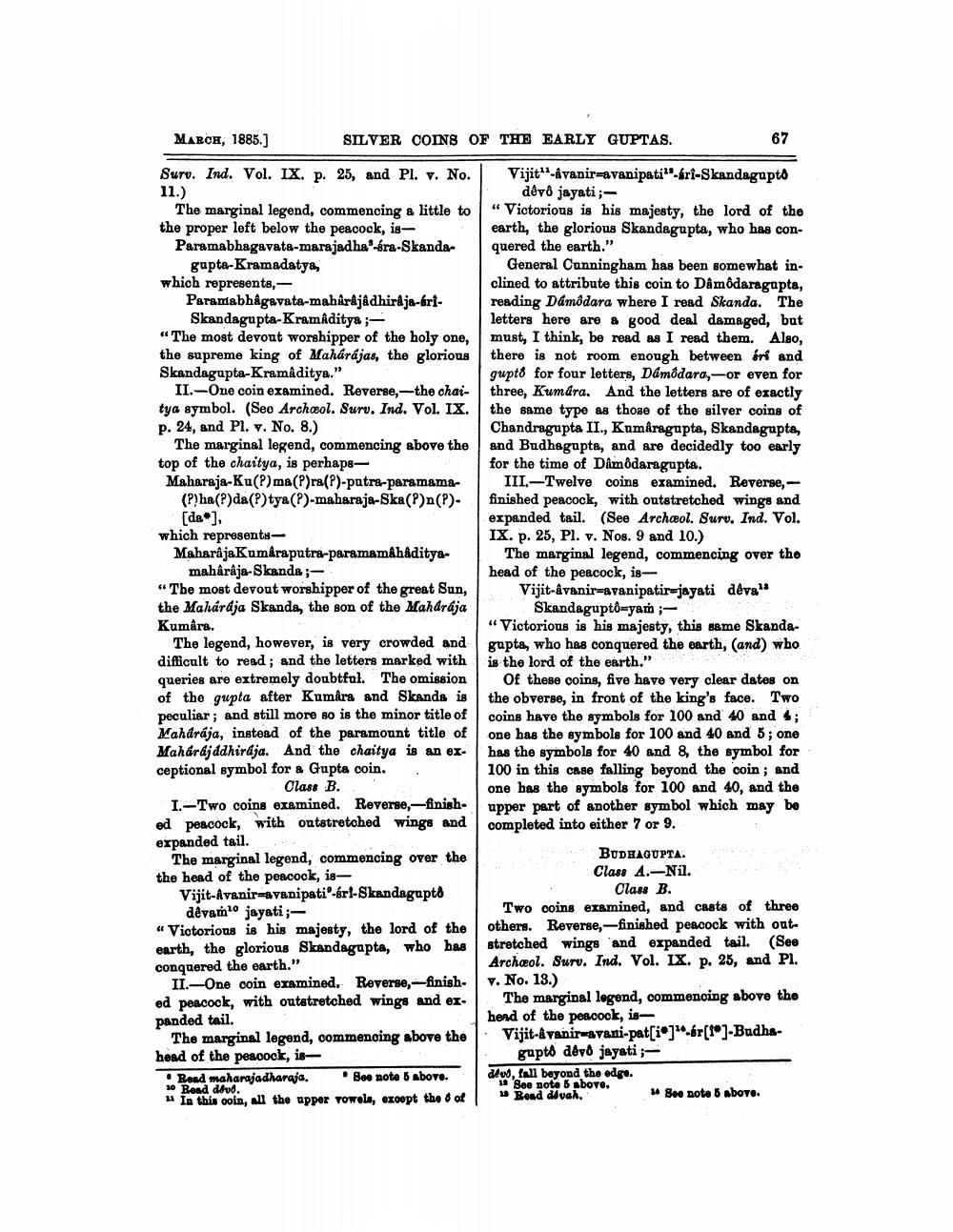________________
MARCH, 1885.]
Surv. Ind. Vol. IX. p. 25, and Pl. v. No. 11.)
The marginal legend, commencing a little to the proper left below the peacock, isParamabhagavata-marajadha-éra-Skanda
gupta-Kramadatya,
SILVER COINS OF THE EARLY GUPTAS.
which represents,
Paramabhagavata-maharjadhirkja-élSkandagupta-Kramaditya ;
"The most devout worshipper of the holy one, the supreme king of Mahúrájas, the glorious Skandagupta-Kramaditya."
II. One coin examined. Reverse,-the chaitya symbol. (Seo Archeol. Surv. Ind. Vol. IX. p. 24, and Pl. v. No. 8.)
The marginal legend, commencing above the top of the chaitya, is perhaps Maharaja-Ku(?) ma(?)ra(?)-putra-paramama(Pha(P)da(P)tya(P)-maharaja-Ska()()
[da*],
which represents
Maharaja Kumaraputra-paramamdhaditya
mahârâja-Skanda;
"The most devout worshipper of the great Sun, the Maharaja Skanda, the son of the Maharaja Kumara.
The legend, however, is very crowded and difficult to read; and the letters marked with queries are extremely doubtful. The omission of the gupta after Kumara and Skanda is peculiar; and still more so is the minor title of Maharaja, instead of the paramount title of Maharajddhirája. And the chaitya is an exceptional symbol for a Gupta coin.
Class B.
I. Two coins examined. Reverse,-finished peacock, with outstretched wings and expanded tail.
The marginal legend, commencing over the the head of the peacock, is
Vijit-Avanir avanipati"-ár1-Skandagupt devamo jayati;
"Victorious is his majesty, the lord of the earth, the glorious Skandagupta, who has conquered the earth."
II-One coin examined. Reverse,-finished peacock, with outstretched wings and expanded tail.
The marginal legend, commencing above the head of the peacock, is
Bead maharajadharaja.
See note 5 above.
10 Read devo.
"In this coin, all the upper vowels, except the 6 of
Vijit"-dranir avanipati".árl-Skandagupt dévô jayati;
"Victorious is his majesty, the lord of the earth, the glorious Skandagupta, who has conquered the earth."
General Cunningham has been somewhat inclined to attribute this coin to Dâmôdaragupta, reading Dámôdara where I read Skanda. The letters here are a good deal damaged, but must, I think, be read as I read them. Also, there is not room enough between ir and gupto for four letters, Dámôdara,-or even for three, Kumara. And the letters are of exactly the same type as those of the silver coins of Chandragupta II., Kumaragupta, Skandagupta, and Budhagupta, and are decidedly too early for the time of Dâmôdaragupta.
III. Twelve coins examined. Reverse,finished peacock, with outstretched wings and expanded tail. (See Archeol. Surv. Ind. Vol. IX. p. 25, Pl. v. Nos. 9 and 10.)
The marginal legend, commencing over the head of the peacock, is
Vijit-Avanir-avanipatir-jayati déva" Skandaguptô-yam ;
"Victorious is his majesty, this same Skandagupta, who has conquered the earth, (and) who is the lord of the earth."
67
Of these coins, five have very clear dates on the obverse, in front of the king's face. Two coins have the symbols for 100 and 40 and 4; one has the symbols for 100 and 40 and 5; one has the symbols for 40 and 8, the symbol for 100 in this case falling beyond the coin; and one has the symbols for 100 and 40, and the upper part of another symbol which may be completed into either 7 or 9.
BUDHAGUPTA. Class A.-Nil. Class B.
Two coins examined, and casts of three others. Reverse,-finished peacock with outstretched wings and expanded tail. (See Archeol. Surv. Ind. Vol. IX. p. 25, and Pl. v. No. 13.)
The marginal legend, commencing above the head of the peacock, isVijit-Avanir-avani-pat[i®]1-ár[1®]-Budha
gupto dêvô jayati;
dévé, fall beyond the edge. 13 See note 5 above. 18 Bead dévah.
14 See note 5 above.




